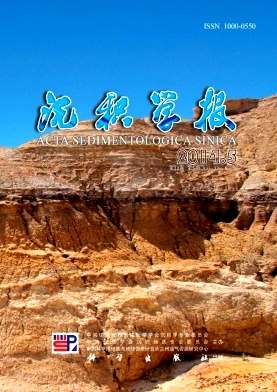|
[1]
|
龚一鸣, 胡斌, 卢宗盛, 等. 中国遗迹化石研究80年[J]. 古生物学报, 2009, 48(3):322-337[Gong Yiming, Hu Bin, Lu Zongsheng, et al. Study of trace fossils in the past eighty years in China[J]. Acta Palaeontologica Sinica, 2009, 48(3): 322-337] |
|
[2]
|
胡斌, 齐永安. 华北上石炭统太原组灰岩中的Zoophycos痕迹组构[J]. 煤田地质与勘探, 2000, 28(1):12-15[Hu Bin, Qi Yong'an. Zoophycos ichnofabric in limestones of Taiyuan Formation, North China[J]. Coal Geology & Exploration, 2000, 28(1): 12-15] |
|
[3]
|
胡斌, 周方, 宋慧波. 河南焦作地区下二叠统太原组遗迹化石及其沉积环境[J]. 古地理学报, 2010, 12(5):577-588[Hu Bin, Zhou Fang, Song Huibo. Ichnofossils and their sedimentary environments in the Lower Permian Taiyuan Formation in Jiaozuo area, Henan province[J]. Journal of Palaeogeography, 2010, 12(5): 577-588] |
|
[4]
|
Hu Bin, Song Huibo, Liu Shunxi, et al. Sedimentary facies, ichnofossils and storm deposits in the Lower Permian Taiyuan Formation, Jiaozuo city, Henan province, central China[J]. Acta Geologica Polonica, 2010, 60(1): 45-52 |
|
[5]
|
Seilacher A. Bathymetry of trace fossils[J]. Marine Geology, 1967, 5(5/6): 413-428 |
|
[6]
|
Wetzel A, Werner F. Morphology and ecological significance of Zoophycos in deep-sea sediments off NW Africa[J]. Palaeogeography, Palaeoclimatology, Palaeoecology, 1981, 32: 185-212 |
|
[7]
|
Wetzel A. The New Zealand Zoophycos revisited: morphology, ethology, and paleoecology-some notes for clarification[J]. Ichnos, 1992, 2: 91-92 |
|
[8]
|
Olivero D. Zoophycos distribution and sequence stratigraphy. Examples from the Jurassic and Cretaceous deposits of Southeastern France[J]. Palaeogeography, Palaeoclimatology, Palaeoecology, 1996, 123(1/2/3/4): 273-287 |
|
[9]
|
Olivero D. Early Jurassic to Late Cretaceous evolution of Zoophycos in the French Subalpine Basin (southeastern France)[J]. Palaeogeography, Palaeoclimatology, Palaeoecology, 2003, 192(1/2/3/4): 59-78 |
|
[10]
|
Kotake N. Paleoecology of the Zoophycos producers[J]. Lethaia, 1989, 22(3): 327-341 |
|
[11]
|
Kotake N. Non-selective surface deposit feeding by the Zoophycos producers[J]. Lethaia, 1991, 24(4): 379-385 |
|
[12]
|
Kotake N. Deep-sea echiurans: possible producers of Zoophycos[J]. Lethaia, 1992, 25(3): 311-316 |
|
[13]
|
Bromley R G.Zoophycos: strip mine, refuse dump, cache or sewage farm?[J]. Lethaia, 1991, 24(4): 460-462 |
|
[14]
|
Löwemark L, Schäfer P. Ethological implications from a detailed X-ray radiograph and 14C study of the modern deep-sea Zoophycos [J]. Palaeogeography, Palaeoclimatology, Palaeoecology, 2003, 192(1/2/3/4): 101-121 |
|
[15]
|
Fu S, Werner F. Is Zoophycos a feeding trace?[J]. Neus Jahrbuch fur Geologie und Paläontologie, Abhandlungen, 1995, 195(1/2/3): 37-47 |
|
[16]
|
Miller W, D' Alberto L. Paleoethologic implications of Zoophycos from Late Cretaceous and Paleocene limestones of the Venetian Prealps, northeastern Italy[J]. Palaeogeography, Palaeoclimatology, Palaeoecology, 2001, 166(1/2): 237-247 |
|
[17]
|
Bromley R G, Hanken N M. Structure and function of large, lobed Zoophycos, Pliocene of Rhodes, Greece[J]. Palaeogeography, Palaeoclimatology, Palaeoecology, 2003, 192(1/2/3/4): 79-100 |
|
[18]
|
Gong Y M, Xu R, Xie S C, et al. Microbial and molecular fossils from the Permian Zoophycos in South China[J]. Science in China Series D: Earth Sciences, 2007, 50(8): 1121-1127 |
|
[19]
|
Gong Y M, Shi G R, Weldon E A, et al. Pyrite framboids interpreted as microbial colonies within the Permian Zoophycos spreiten from southeastern Australia[J]. Geological Magazine, 2008, 145(1): 95-103 |
|
[20]
|
Gong Y M, Shi G R, Zhang L J, et al. Zoophycos composite ichnofabrics and tiers from the Permian neritic facies in South China and south-eastern Australia[J]. Lethaia, 2010, 43(2): 182-196 |
|
[21]
|
宋慧波, 胡斌, 张璐, 等. 河南省太原组沉积时期岩相古地理特征[J]. 沉积学报, 2011, 29(5):876-888[Song Huibo, Hu Bin, Zhang Lu, et al. Characteristics of lithofacies paleogeography of the Taiyuan Formation sedimentary period, Henan province[J]. Acta Sedimentologica Sinica, 2011, 29(5): 876-888] |
|
[22]
|
宋慧波, 金毅, 胡磊, 等. 豫西地区下二叠统太原组遗迹组构及其沉积环境[J]. 地质学报, 2012, 86(6):972-984[Song Huibo, Jin Yi, Hu Lei, et al. Ichnofabrics and their sedimentary environment of the Lower Permian Taiyuan Formation, western Henan[J]. Acta Geologica Sinica, 2012, 86(6): 972-984] |
|
[23]
|
吴贤涛, 胡斌, 王观忠, 等. 豫西焦作地区上石炭统浅海碳酸盐中的风暴沉积[J]. 沉积学报, 1987, 5(4):1-13[Wu Xiantao, Hu Bin, Wang Guanzhong, et al. Storm deposits in Upper Carboniferous shallow marine carbonates of Jiaozuo, Henan[J]. Acta Sedimentologica Sinica, 1987, 5(4): 1-13] |
|
[24]
|
河南省地质矿产局. 河南省区域地质志[M]. 北京:地质出版社, 1989:205-214[Henan Department of Geology and Mineral Industries. Regional Geology of Henan Province[M]. Beijing: Geological Publishing House, 1989: 205-214] |
|
[25]
|
龚一鸣, 徐冉, 谢树成, 等. 遗迹化石Zoophycos中的微生物和分子化石[J]. 中国科学(D辑):地球科学, 2007, 37(6):713-719[Gong Yiming, Xu Ran, Xie Shucheng, et al. Microorganism and molecular fossil in Zoophycos ichnofossil[J]. Science China (Seri. D): Earth Sciences, 2007, 37(6): 713-719] |
|
[26]
|
杨克红, 初凤友, 赵建如, 等. 南海北部冷泉碳酸盐岩矿物微形貌及其意义探讨[J]. 矿物学报, 2009, 29(3):345-352[Yang Kehong, Chu Fengyou, Zhao Jianru, et al. Minerals' micro-shape and its significance of seep carbonates in the North of the South China Sea[J]. Acta Mineralogica Sinica, 2009, 29(3): 345-352] |
|
[27]
|
温志峰, 刘显太, 钟建华, 等. 柴达木盆地新近纪叠层石中微生物化石组合的发现与钙化方式研究[J]. 地质学报, 2010, 84(2):263-271[Wen Zhifeng, Liu Xiantai, Zhong Jianhua, et al. Discovery of microorganism fossil and study on microorganism induced calcification in Miocene stromatolites, Qaidam Basin, China[J]. Acta Geologica Sinica, 2010, 84(2): 263-271] |






 DownLoad:
DownLoad: